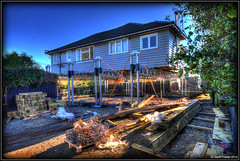
Search
Images for Earthquakes; more images...
CCC and EQC in talks about area-wide land remediation for CHCH
Audio, Radio New Zealand
Owners of earthquake-damaged land in Christchurch may not get an individual payout from the Earthquake Commission if it goes ahead instead with a more widespread approach to fixing the land.
Avon-Otakaro network
Other, National Library of New Zealand
About the Network (AvON) and its plans to create a park and reserve in the Christchurch red zone around the Avon River. Includes resources and information about its projects.
Low frequency (f=1Hz) ground motion simulations of 10 events in the 2010-2…
Research papers, University of Canterbury Library
None
Blessed Rainbow
Images, eqnz.chch.2010
Catholic Basilica, Christchurch - at the right place, at the right time...
Recent efforts in empirical ground motion modelling in New Zealand
Research papers, University of Canterbury Library
This presentation discusses recent empirical ground motion modelling efforts in New Zealand. Firstly, the active shallow crustal and subduction interface and slab ground motion prediction equations (GMPEs) which are employed in the 2010 update of the national seismic hazard model (NSHM) are discussed. Other NZ-specific GMPEs developed, but not incorporated in the 2010 update are then discussed, in particular, the active shallow crustal model of Bradley (2010). A brief comparison of the NZ-specific GMPEs with the near-source ground motions recorded in the Canterbury earthquakes is then presented, given that these recordings collectively provide a significant increase in observed strong motions in the NZ catalogue. The ground motion prediction expert elicitation process that was undertaken following the Canterbury earthquakes for active shallow crustal earthquakes is then discussed. Finally, ongoing GMPE-related activities are discussed including: ground motion and metadata database refinement, improved site characterization of strong motion station, and predictions for subduction zone earthquakes.
Representative ground motion ensembles for several major earthquake scenar…
Research papers, University of Canterbury Library
This paper develops representative ground motion ensembles for several major earthquake scenarios in New Zealand. Cases considered include representative ground motions for the occurrence of Alpine, Hope, and Porters Pass earthquakes in Christchurch, and the occurrence of Wellington, Wairarapa, and Ohariu, fault ruptures in Wellington. Challenges in the development of ground motion ensembles for subduction zone earthquakes are also highlighted. The ground motions are selected based on the generalized conditional intensity measure (GCIM) approach, ensuring that the ground motion ensembles represent both the mean, and distribution of ground motion intensity which such scenarios could impose. These scenario-based ground motion sets can be used to complement ground motions which are often selected in conjunction with probabilistic seismic hazard analysis, in order to understand the performance of structures for the question “what if this fault ruptures?”
None
Images, eqnz.chch.2010
None
Crumbled
Images, eqnz.chch.2010
"Open Theatre" - The Odeon Built in 1883 and known as the Tuam Street Hall or Theatre and was New Zealand's oldest masonry, purpose built theatre. In 1930, it became the St. James Theatre, It became The Odeon Movie Theatre in 1960. Demolition started in September 2012 after the Christchurch earthquakes of 2010/2011 but seems to have stopped!?
Busker
Images, eqnz.chch.2010
None
Emily's Story
Articles, UC QuakeStudies
Summary of oral history interview with Emily about her experiences of the Canterbury earthquakes.
June Tiopira's Story
Articles, UC QuakeStudies
Summary of oral history interview with June Tiopira about her experiences of the Canterbury earthquakes.
None
Images, eqnz.chch.2010
None
None
Images, eqnz.chch.2010
None
None
Images, eqnz.chch.2010
None
None
Images, eqnz.chch.2010
None
None
Images, eqnz.chch.2010
None
None
Images, eqnz.chch.2010
None
None
Images, eqnz.chch.2010
None
None
Images, eqnz.chch.2010
None
None
Images, eqnz.chch.2010
None
Brightening The City
Images, eqnz.chch.2010
None
None
Images, eqnz.chch.2010
None
None
Images, eqnz.chch.2010
None
Select liquefaction case histories from the 2010-2011 Canterbury earthquak…
Research papers, University of Canterbury Library
The 2010–2011 Canterbury earthquake sequence began with the 4 September 2010, Mw7.1 Darfield earthquake and includes up to ten events that induced liquefaction. Most notably, widespread liquefaction was induced by the Darfield and Mw6.2 Christchurch earthquakes. The combination of well-documented liquefaction response during multiple events, densely recorded ground motions for the events, and detailed subsurface characterization provides an unprecedented opportunity to add well-documented case histories to the liquefaction database. This paper presents and applies 50 high-quality cone penetration test (CPT) liquefaction case histories to evaluate three commonly used, deterministic, CPT-based simplified liquefaction evaluation procedures. While all the procedures predicted the majority of the cases correctly, the procedure proposed by Idriss and Boulanger (2008) results in the lowest error index for the case histories analyzed, thus indicating better predictions of the observed liquefaction response.
The Demise of the URM Building Stock in Christchurch during the 2010–2011 …
Research papers, The University of Auckland Library
The progressive damage and subsequent demolition of unreinforced masonry (URM) buildings arising from the Canterbury earthquake sequence is reported. A dataset was compiled of all URM buildings located within the Christchurch CBD, including information on location, building characteristics, and damage levels after each major earthquake in this sequence. A general description of the overall damage and the hazard to both building occupants and to nearby pedestrians due to debris falling from URM buildings is presented with several case study buildings used to describe the accumulation of damage over the earthquake sequence. The benefit of seismic improvement techniques that had been installed to URM buildings is shown by the reduced damage ratios reported for increased levels of retrofit. Demolition statistics for URM buildings in the Christchurch CBD are also reported and discussed. VoR - Version of Record
Ready to go
Images, eqnz.chch.2010
None
The Food Court
Images, eqnz.chch.2010
None
None
Images, eqnz.chch.2010
None
Love and Loss
Images, eqnz.chch.2010
None
Interview with Alice Ridley
Audio, UC QuakeStudies
Oral history interview with Alice Ridley about her experiences of the Canterbury earthquakes.



